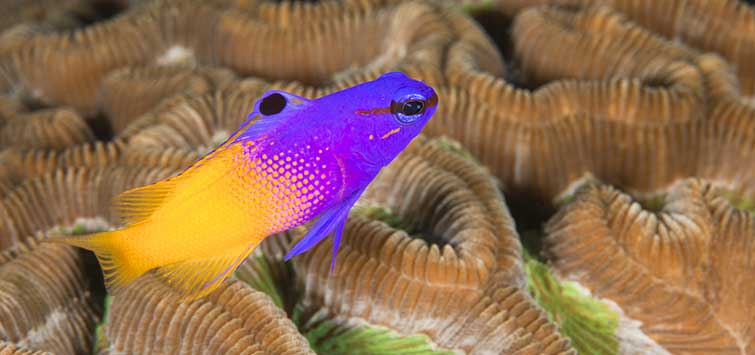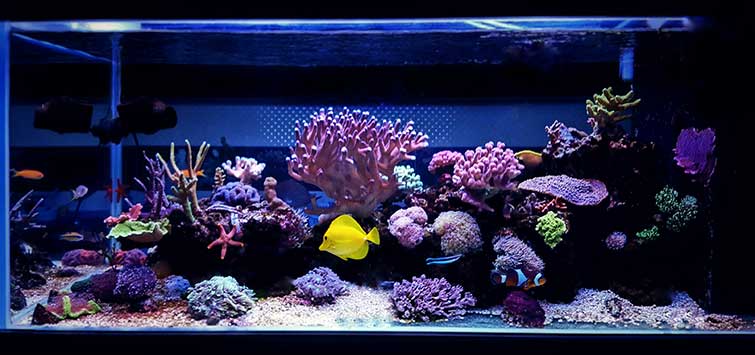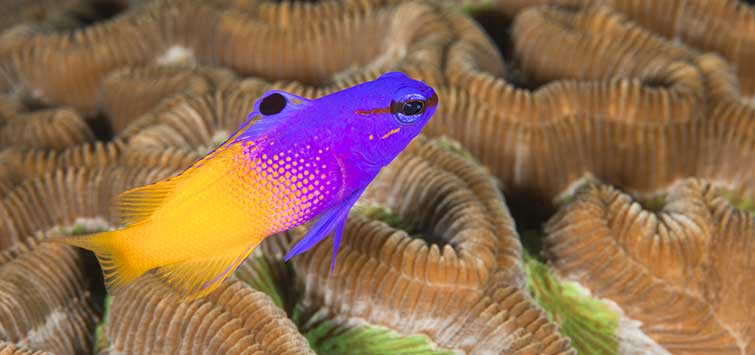The Grammas: True Treasures of the Caribbean
Author: Jeff Kurtz
During the Golden Age of Piracy (circa 1690 to 1730), notorious, ruthless, and opportunistic seafarers such as Sir Henry Morgan, Blackbeard, and Calico Jack plied the waters of the Caribbean, raiding ships and seaport towns to plunder, pillage, and amass treasure. Little did these infamous buccaneers realize that the true treasure of the Caribbean actually lies beneath the waves, for it is there that the piscine “pearls” known as the grammas can be found.
Okay, so Blackbeard and his ilk probably gave less than a fig about the fish species residing on the treacherous reefs that constantly threatened to tear their ships’ hulls apart—or cared about them only insofar as they were fit for the cooking pot. But had Blackbeard been a marine aquarium hobbyist, I’m confident that he would have valued the grammas above even his fabled whiskers.
Hopelessly fractured history lesson aside, these beautiful basslets, belonging to the family Grammatidae, truly are a treasure and are exceptionally well suited to aquarium living—even for hobby newcomers.
The family Grammatidae consists of two genera, Gramma and Lipogramma. At least two members of the genus Gramma, G. loreto and G. melacara, are of special interest to our hobby and are regulars in the marine aquarium trade, with G. loreto being far and away the more popular and available of the two. The Lipogramma species would make suitable aquarium denizens, as well, but most aren’t as vividly colored as the Gramma species I’ll discuss here. And, as they are secretive species that reside in deep-water habitats, their capture is no small undertaking.
In nature, grammas favor habitat with abundant caves, crevices, and overhangs for concealment. Hence, in the aquarium, they require ample live rock with a honeycomb of bolt holes in which to hide. Specimens typically hover in close proximity to, or just inside of, a favored refuge. Amusingly enough, grammas tend to position themselves with their bellies toward a solid substrate, which in their craggy habitat could mean the ceiling of a cave or ledge or a vertical wall, so they are often observed hovering in an upside-down position or at other peculiar angles. This is normal behavior—not a sign that the fish is ailing or disoriented.
Trustworthy Reef Inhabitants
Grammas achieve a relatively diminutive adult size of 3 to 4 inches. That, coupled with their generally peaceful disposition toward other fish species and sessile reef invertebrates, gives them a solid reputation as trustworthy reef tank inhabitants. Their ability to adapt readily to aquarium fare, such as mysid shrimp, brine shrimp, chopped fish or shellfish, and other meaty offerings, makes them all the more desirable. They’ll even learn to accept flake and freeze-dried foods in time. Offering a variety of nutritious foods is one key to maintaining these fish in superior health and keeping their splendid colors as bright as can be.
They are not especially aggressive toward other species, but like so many other reef fish, grammas will squabble with conspecifics within the confines of the aquarium, so it’s safest to keep them one to a tank. This is an extremely frustrating limitation for those fortunate underwater explorers who have had the opportunity to observe large aggregations of these extraordinarily beautiful fish in their natural home on the reef.
I’ve read numerous reports that groups of grammas can be kept successfully in large systems, but my inclination is always to err on the side of caution in this regard. The question that comes to my mind is: How big does a system have to be in order to be big enough to keep more than one gramma (or whichever species is in question) to a tank? Some experts say 100 gallons. Some say much more. Some say much less. Who’s to say who’s right? Would I wager the serenity of my aquarium on the answer to that question? Don’t bet your life on it!
Notorious Jumpers
One other note of caution about the grammas is that they are notorious jumpers, so a good tight-fitting cover is a must. Even a seemingly insignificant gap in the cover can serve as an escape hatch and lead to “death by desiccation” on the floor, especially while a newly introduced specimen is in the process of acclimating.
I once had a royal gramma specimen that would repeatedly fling itself through a small notch in my acrylic aquarium cover (cut out to accommodate the overflow of my trickle-down biofilter) and somehow wind up in the external chamber of the overflow, which hangs from the back of the tank. I suspect it landed first in the internal chamber and was transported via the continuous siphon into the external chamber—but that’s just a theory. Every few days or so I would notice that the little critter didn’t emerge from its usual hiding place at feeding time and, invariably, I’d find it trapped in the overflow chamber.
After observing the fish closely for a few days, I noticed that it became very skittish and jumpy right after I turned the lights out at night, which is understandable since small fish left exposed after dark on the coral reef are extremely vulnerable to the myriad nocturnal predators that go on the prowl after sunset. What helped to soothe the fish and interrupt this skittish behavior was timing the lights so the actinic lamps stayed on for an extra hour after the “daylight” lamps turned off, providing a period of twilight rather than a sudden, startling onset of darkness.
So now that we know a little more about the grammas in general, let’s narrow our focus to the two gramma species mentioned briefly above, beginning with the royal gramma Gramma loreto, also known as the fairy basslet.
Gramma loreto
In my humble opinion, this attractive species is among the very best choices available for either the fish-only or mini-reef system provided it is housed with species of similar size and peaceful disposition. Overly aggressive tankmates, such as damsels or dottybacks, will drive this species into perpetual hiding where it will eventually perish from stress and starvation.
G. loreto is stunningly colored with a violet-purple anterior half giving way abruptly to a bright-yellow posterior half. Faint yellow streaks radiate back from each eye, and a distinct black spot appears on the anterior portion of the dorsal fin. In maximum length, it achieves approximately 3 inches, though I’ve seen a few robust specimens over the years that appeared to be even larger.
The closely related Brazilian gramma Gramma brasiliensis is similar in coloration to G. loreto but has a larger mouth and lacks the yellow lines extending from the eyes. Scott Michael reports in his book Basslets, Dottybacks & Hawkfishes (TFH/Microcosm Professional Series, 2004) that G. brasiliensis is more aggressive than G. loreto and that it is more risky to keep two of them together (in tanks smaller than 75 gallons) or to house the species with smaller, more passive fishes.
Don’t Pick Pseudochromis paccagnellae by Mistake
Also, if you’re looking for a royal gramma at your local fish store, don’t make the mistake of picking out the very similarly named and almost identically colored royal dottyback Pseudochromis paccagnellae instead. Though this species may look the same at first glance and reaches approximately the same maximum size, it couldn’t be more different in temperament. P. paccagnellae is belligerent in the extreme and is known to take on fish many times its own size. And it doesn’t limit its aggression to conspecifics, either. Any fish that isn’t equally cantankerous or large enough to hold its own against this hothead is considered fair game.
Coloration
One interesting characteristic of the royal gramma is that its coloration tends to fade when water conditions are less than ideal, so this species has long been considered an aquatic “canary in the coal mine” of sorts, providing a visual warning of declining water quality. However, if you stay on top of routine maintenance and water changes, your beautiful royal gramma should never have to suffer ill health and lose its spectacular coloration just to serve as a beacon for deteriorating water quality.
Gramma melacara
As I’ve mentioned, G. loreto is the more commonly available and widely recognized of the two gramma species we’re discussing here. That’s because it is found at shallower depths, making it more accessible for collection (not to mention generally easier on the pocketbook). The blackcap basslet G. melacara, on the other hand, is found in greatest abundance in deeper waters and is, therefore, much more of a challenge for divers to collect. Is this little gem of a fish worth the increased risk of decompression sickness and nitrogen narcosis that divers face while pursuing it? Many would argue “yes.”
G. melacara is quite breathtaking, chromatically speaking, sporting a radiant purple overall coloration and a black “cap” extending diagonally from its mouth through its dorsal fin. Faint white lines extend backward from each eye. Its behavior in the aquarium is similar to that of G. loreto, though with age it reportedly becomes more aggressive in defense of its favorite cave or bolt hole than G. loreto does. Hailing as it does from deeper waters, G. melacara does best when acclimated to the aquarium under subdued lighting rather than the intense glare of full-blown reef lighting. Over time, it will acclimate to the more intense lighting, but this shy species may spend much of its time in hiding at first. Also, as with G. loreto, this species needs an abundance of caves, crevices, nooks, crannies, and walls in order to feel right at home.
True Treasures
Of all the marine fish species available to aquarists, I’m especially fond of those that exhibit character and personality—and these two species have personality in spades. Grammas seem to be keeping an eye on you and appraising your actions almost as much as you are keeping tabs on them, which seems to beg the proverbial question, Who is watching who in this situation? But that’s just one of the many fascinating aspects of these fish that make them true Caribbean treasures.

.png?h=595&iar=0&w=2781&hash=5FD5E69473BCC22199FBFA2FB71B6033)



